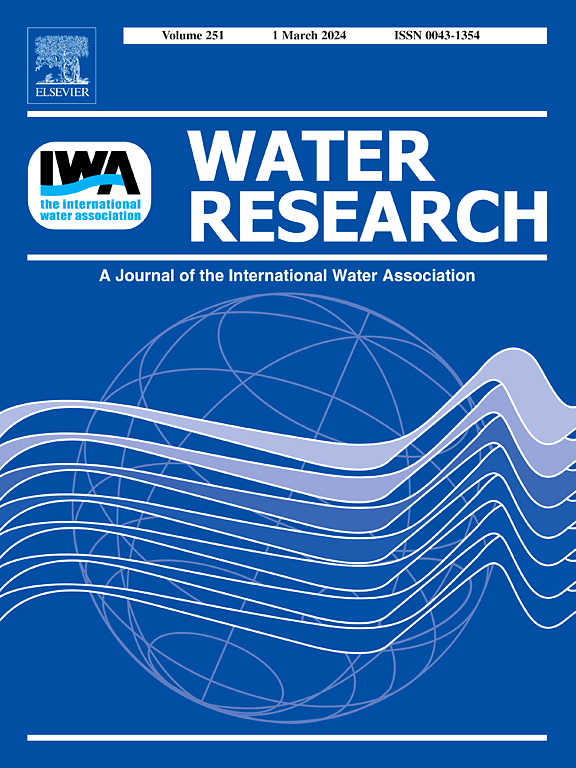工业循环水养殖系统中功能微生物协同变化介导的氮磷耦合循环
IF 11.4
1区 环境科学与生态学
Q1 ENGINEERING, ENVIRONMENTAL
引用次数: 0
摘要
工业循环水产养殖系统(IRAS)是一种可持续和有效的水产养殖方法,在节约用水和环境管理方面具有重大效益。全面了解氮(N)和磷(P)循环对于优化系统设计和操作策略至关重要,从而使IRAS内的生态系统保持平衡。本研究采用宏基因组学方法,对IRAS对虾养殖池(AP)和硝化池(NT)的水体微生物群落进行了研究,探讨了氮磷耦合循环的机制。结果表明:(1)氮素和磷循环基因在AP水中比在NT中更丰富,具有更高的降解有机N和P化合物、硝酸盐还原、反硝化和AP中磷酸盐吸收的潜力;它们的宿主(功能菌)分别为:还原硝酸盐的Marivivens菌、水解有机磷的Polaribacter和Erythobacter菌、吸收磷酸盐的Fluviibacter和Sediminibacterium;(2)通过功能基因的丰度观察到氮磷循环的耦合,这可能是由宿主组成的协调变化介导的,而亚硝酸盐含量是影响这种变化的关键因素;几种同时拥有氮和磷循环基因的细菌被鉴定出来,主要参与有机氮和磷化合物的降解、反硝化和磷酸盐的吸收。本研究强调了IRAS中N和P循环的耦合以及功能细菌在维持水质中的重要作用。研究结果还对管理和改进IRAS以促进更有效的水产养殖活动具有重要意义。本文章由计算机程序翻译,如有差异,请以英文原文为准。
Coupled nitrogen and phosphorus cycles mediated by coordinated variations of functional microbes in industrial recirculating aquaculture system
Industrial Recirculating Aquaculture Systems (IRAS) represent a sustainable and efficient approach to aquaculture, offering significant benefits in water conservation and environmental management. A comprehensive understanding of nitrogen (N) and phosphorus (P) cycling is essential for optimizing system design and operational strategies, enabling the maintenance of a balanced ecosystem within IRAS.Here, water microbial communities in the shrimp aquaculture pond (AP) and nitrification tank (NT) of the IRAS were investigated using a metagenomics-based approach to explore the mechanisms of N and P coupling cycles. Results showed that (1) N and P cycling genes were more abundant in AP water than in NT, with higher potentials for degrading organic N and P compounds, nitrate reduction, denitrification, and phosphate uptake in AP; and their hosts (functional bacteria) were identified as Marivivens for nitrate reduction, Polaribacter and Erythobacter for organophosphorus hydrolysis, and Fluviibacter and Sediminibacterium for phosphate uptake; (2) the coupling of N and P cycles was observed through the abundance of functional genes, likely mediated by coordinated variations in host composition, with nitrite content as a key factor influencing this variation; several bacterial species possessing both N and P cycling genes were identified, primarily engaged in the degradation of organic N and P compounds, denitrification, and phosphate uptake.This study highlights the coupling of N and P cycling in IRAS and the important role of functional bacteria in maintaining water quality. The results also have important implications for the management and improvement of IRAS for more effective aquaculture activities.
求助全文
通过发布文献求助,成功后即可免费获取论文全文。
去求助
来源期刊

Water Research
环境科学-工程:环境
CiteScore
20.80
自引率
9.40%
发文量
1307
审稿时长
38 days
期刊介绍:
Water Research, along with its open access companion journal Water Research X, serves as a platform for publishing original research papers covering various aspects of the science and technology related to the anthropogenic water cycle, water quality, and its management worldwide. The audience targeted by the journal comprises biologists, chemical engineers, chemists, civil engineers, environmental engineers, limnologists, and microbiologists. The scope of the journal include:
•Treatment processes for water and wastewaters (municipal, agricultural, industrial, and on-site treatment), including resource recovery and residuals management;
•Urban hydrology including sewer systems, stormwater management, and green infrastructure;
•Drinking water treatment and distribution;
•Potable and non-potable water reuse;
•Sanitation, public health, and risk assessment;
•Anaerobic digestion, solid and hazardous waste management, including source characterization and the effects and control of leachates and gaseous emissions;
•Contaminants (chemical, microbial, anthropogenic particles such as nanoparticles or microplastics) and related water quality sensing, monitoring, fate, and assessment;
•Anthropogenic impacts on inland, tidal, coastal and urban waters, focusing on surface and ground waters, and point and non-point sources of pollution;
•Environmental restoration, linked to surface water, groundwater and groundwater remediation;
•Analysis of the interfaces between sediments and water, and between water and atmosphere, focusing specifically on anthropogenic impacts;
•Mathematical modelling, systems analysis, machine learning, and beneficial use of big data related to the anthropogenic water cycle;
•Socio-economic, policy, and regulations studies.
 求助内容:
求助内容: 应助结果提醒方式:
应助结果提醒方式:


